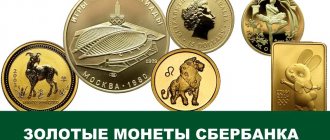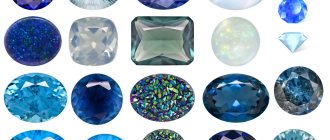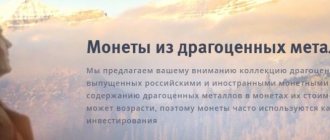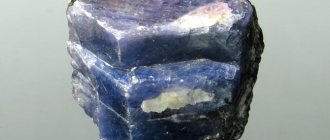Good afternoon, dear readers! The market for precious metals has existed since ancient times, although not in its current form. One of the most famous participants in this market, Judas Iscariot, valued the life of Jesus Christ at thirty pieces of silver (about 400 g of silver). Converting this silver at the average rate of 2018, we get about 13,000 rubles - it turns out that Judas received one month’s salary of an auto mechanic from the Kemerovo region for his historical kiss.
Today we’ll see what modern silver pieces look like.
What it is
A market in a general sense is a system of interactions that arise during the exchange of material goods. The concept of a market is relatively new, but its essence has not changed over the past millennia, although a manager watching numbers on a computer screen does not look much like a caveman carrying skins to sell to a neighboring tribe.
The global precious metals market is understood as a set of economic relations that arise in the process of trading metals and securities quoted in gold.
The precious metals market has a peculiarity. The fact is that metals never performed a single function, but were used in two capacities:
- monetary - they measured the cost of goods;
- actual commodity.
And now, in addition to jewelry and investment gold, platinum, silver and palladium, a huge amount of production and technical metal is consumed. It is needed by many industries.
Content
- Summary
- Gem market
- Geographical structure of the world diamond market.
- Players in the global diamond market
- Russian diamond market
- Synthetic diamond market
- Regulation of the diamond market
- Consequences of the COVID-19 pandemic
Anton Tabakh, Managing Director for Macroeconomic Analysis and Forecasting, Expert RA
Anastasia Podrugina, lecturer at the Faculty of World Economy and International Politics, National Research University Higher School of Economics
Brief history of formation
For a long time, gold and silver (platinum and palladium were not mined until the 20th century) were a measure of the value of a commodity - money was minted from them in prehistoric times. When people appreciated the convenience of using gold as a reference currency, a real technological breakthrough occurred: the mining and metallurgical industries developed.
Over time, precious metals were withdrawn from direct participation in trade as money (such coins were too expensive, difficult to transport, heavy and prone to deformation). In their place came paper money—essentially, gold certificates that could be exchanged for a certain amount of gold.
Precious metals have long remained the most stable currency, which people especially counted on in times of wars and crises. In the 19th century, many countries officially introduced the gold standard.
Expert opinion
Lyudmila Pestereva
Our most experienced gold investor
Ask a Question
The global precious metals market has undergone significant changes over the past century before it took on its modern form. This was influenced by the abolition of the gold standard (refusal of the free exchange of money for a specific gold unit). In 1971, the US finally abolished the gold backing of the dollar, and gold was demonetized - it ceased to serve as money.
There is a point of view among economists that demonetization has not yet been completed and gold continues to serve as the world’s “reserve fund.” However, now precious metals are sold and bought in commodity form for national currency.
Proponents of partial demonetization are right that gold is used as a reserve asset, but we can confidently say that it has lost most of its monetary functions.
Functions
A metal trading system is necessary so that market participants can carry out the operations they need:
- Purchase of precious metals for industrial and household consumption, investment, and risk insurance.
- Sales of mined precious metals.
- Speculation - obtaining benefits as a result of successfully predicting exchange rate fluctuations (“playing on the stock exchange”).
The precious metals market satisfies all these needs. Technologies for the development of ore deposits are developing, and gold and silver (to a lesser extent platinum and palladium) remain stable enough in value that it is not scary to invest in them. At the same time, exchange rate fluctuations allow the metal to be used for speculation.
Kinds
Precious metals markets differ in the level of government regulation of transactions performed, the residence of participants and the amounts of transactions. Let's look at one of the main classifications.
International
These are the largest markets in the world, where trade is carried out between corporations from different countries. They are characterized by high volumes, a variety of available transactions, and wholesale supplies.
A distinctive feature of such a market is customs and tax benefits.
Domestic
Domestic markets mainly serve investors. Their scope of activity extends to one or more neighboring countries (for example, the Turkish market operating in the Middle East). Traded gold is taxed according to the laws of the country where the market is based.
Based on the level of government intervention in the operation of domestic markets, they are divided into:
- free (almost no control);
- regulated (there are quotas, licenses, restrictions on export and import);
- closed (strict restrictions, full control).
Closed markets operate in Greece, Egypt, and Pakistan. Participation in trading on them is greatly complicated by state bans, which leads to the emergence of another type of market - black markets.
Black
Shadow markets are a consequence of excessive government rigidity in establishing trade frameworks that make it unprofitable and difficult to access. The largest center of illegal gold trading is Mumbai (until 1995 - Bombay) in India.
After the India-China War in 1962, the Indian government banned private ownership of investment gold, which led to the establishment of an underground trading network.
Synthetic Diamond Market
Summary.
The shadow segment of the business spoils the reputation of the natural stone market. The market for synthetic diamonds - diamonds grown in laboratories - occupies a small share of the market as a whole, according to various estimates - 3-4%. The main producers in this market are China and India, the market is growing rapidly - in 2021 its growth amounted to 15-20%. The main consumer of synthetic stones is the USA.
It is difficult to imagine that synthetic diamonds will be able to completely displace natural stones from the market. “Diamonds are forever,” De Beers declared in its 1940s advertising campaign. Although the market for artificial diamonds has its buyers, the so-called “Generation Z” is shifting towards a model of reasonable consumption that involves environmental and social responsibility.
However, the biggest threat to the natural stone market comes not from a change in consumption patterns, but from the shadow market. Currently, the market for synthetic diamonds has not fully developed into a separate market; synthetic diamonds are often mixed with natural diamonds: one can only be distinguished from the other in a gemological laboratory. According to Alrosa estimates, about 80% of laboratory-grown diamonds are sold according to this scheme. The semi-legal position of the market for artificial diamonds causes serious damage to the market for natural stones - a real “market for lemons” of Akerlof is being formed.
The market for lemons is a market model with information asymmetry published by J. Akerlof in 1970. Akerlof cited the example of the used car market, where buyers do not have reliable information about the quality of the car and are therefore not willing to pay a high price for a car that may be of poor quality. This leads to the displacement of high-quality cars from the market, and then to the complete disappearance of the market.
Diamond mining giants use various strategies to reduce information asymmetry. So Alrosa released a serial device, ALROSA Diamon Detector, which allows you to distinguish natural stone from laboratory-grown stone.
De Beers is investing in the production of synthetic stones; in 2018, the company created a separate brand, Lightbox, under which it sells products made from laboratory-grown diamonds.
One of the largest retailers of diamond jewelry, Tiffany & Co, states that it is not engaged and does not plan to sell jewelry with artificial diamonds. As one method of protecting against counterfeit natural diamonds and conflict stones, the company primarily purchases and sells individually registered diamonds larger than 0.18 carats (over 75% of its volume).
Participants
The companies participating in the tenders and thus influencing the situation on the market differ in both scale and type of activity.
Gold mining companies
Owners of mines, mines and mines are the main suppliers of metals to interstate markets. Small businesses most often cannot work with brokers directly and are forced to use the services of intermediaries.
There are also large gold miners: the Canadian company Barrick Gold, which occupies a leading position in the ranking, the Australian Newcrest Mining, and the British Goldcorp. These are corporations that work with the largest volumes and therefore have a huge impact on the situation in the system.
Industrial users
The main clientele of the market are enterprises that process precious metals and turn them into consumer products: jewelry, luxury goods, and high-tech devices. These are jewelry and electrical production, refineries that prepare metal for subsequent remelting.
A distinctive feature of industrial buyers is that they need a product of a certain quality depending on the purpose: for example, only pure metal is suitable for the production of microcircuits, while a jeweler can process gold dust.
Precious metals exchanges
Participants trading on exchanges do not operate with “live” metal, but mainly with futures contracts - agreements for the sale of an asset on special terms. The main purpose of such operations is hedging, that is, price insurance by opening forward transactions to compensate for risks in another market.
The world's largest exchanges are located in London, Shanghai, New York and Tokyo.
Central banks
The most influential ones are in the USA, Great Britain and Germany, but banks in other countries also play an important role - in particular, the Bank of Russia, in whose vaults most of the gold reserves of the Russian Federation are located.
Other countries participating in international trade also store a significant portion of their reserves in the form of physical gold - bullion. The central banks that store these treasures (hundreds and thousands of tons of gold!) are the largest sellers in the metal market.
Professional dealers and intermediaries
This market segment is represented by:
- dealers;
- brokers.
The difference between a dealer and a broker is that the first carries out trade intermediation on his own behalf and at his own expense, while the second (broker) is an intermediary acting at the expense and on behalf of the client. The broker does not become the owner of the assets, cannot dispose of them on his own behalf and works for a commission.
Expert opinion
Lyudmila Pestereva
Our most experienced gold investor
Ask a Question
The dealer's income is generated by the difference between buy and sell quotes (spread). The dealer (unlike the broker) has the right to set a quote for the client independently.
Investors
Investors are companies (for example, pension funds) or individuals who use gold to build savings. Special bars and investment coins are issued for them. There are investors who buy metal without delivery - with the aim of further use for speculative purposes.
Some publications note that investors from Asia are more inclined to purchase precious metals to preserve resources, while European and American investors are increasingly choosing to play on the stock exchange.
Regulation of the diamond market
Summary.
Russia will lead the process of protection against “blood” diamonds for another year. The diamond market - from mining to sales - is regulated quite carefully, although there are regulatory gaps.
The main direction of regulation of the diamond market is protection from so-called “blood diamonds”, stones, the proceeds from the sale of which are used to finance military operations of rebel groups in African countries (Angola, Sierra Leone, Liberia, Cote d'Ivoire and others).
At the international level, regulation is carried out through the Kimberley Process. The Kimberley Process is an international diamond certification scheme created in 2003 to combat illegal diamond mining and the financing of rebel groups from mined diamonds. Currently, 56 countries are participating in the Kimberley Process, collectively producing 99.8% of diamonds. Kimberley Process participants agree to comply with a set of requirements regarding the control of diamonds produced and the exchange of statistical data within the Kimberley Process, and to trade only with Kimberley Process countries that meet a minimum set of requirements. In 2021, Russia chaired the Kimberley Process, but due to the coronavirus pandemic, its chairmanship was also postponed to 2021, and Botswana’s turn to 2022.
The activities of the Kimberley Process are sometimes criticized for insufficient control over the implementation of requirements - it was not possible to completely eradicate the trade in “blood diamonds” in some African countries.
A significant part of the sale of legal diamonds is carried out through diamond exchanges (Belgium, India, Israel, Great Britain and others). The World Federation of Diamond Bourses, in particular, helps to unify trade practices.
Another area of regulation is the labeling of synthetic diamonds. The Kimberley Process is also developing labeling practices for all synthetic stones produced within participating countries. Such practices will help reduce information asymmetries and protect the natural diamond market.
Russia is also developing a system for marking precious stones: the Ministry of Finance estimated the volume of shadow turnover in Russia in the jewelry industry at 58%. From 2021, it is planned to launch a state integrated information system for precious metals and precious stones, which involves marking all precious stones, including rough and polished diamonds, and precious metals. Despite the importance of such labeling described above, it should be noted that it imposes some costs on all participants in the production chain, but the additional costs are likely to be most significant for retailers: before July 1, 2021, all stock will be required to be labeled.
Largest gold trading centers in the world
The first on the list of leading platforms is, of course, the legendary London Interbank Market. London has been setting gold prices for almost a hundred years - since 1919, when the London fixing was established. Until 2015, the price of gold was formed using the fixing method (the exception was the war and post-war years, when people had no time for exchanges). Fixing gave way to an electronic auction in 2015, but London remains the world's gold trading center.
The London market sets strict requirements for traded gold: all of it must be marked Good Delivery - “good delivery” - and meet the quality standard.
Another market leader is Zurich. Switzerland imports up to 40% of the world's gold supply. The peculiarity of Swiss banks is that they have representative offices in most countries that actively trade in precious metals: in the USA (New York), Australia (Melbourne), and in the Far East (Singapore, Hong Kong, Japan).
In the Middle East, the main free domestic markets are in the UAE (Dubai) and Turkey. In Europe you can also note Paris, Milan and Frankfurt am Main, in Asia - Karachi and Dhaka, in Africa - Alexandria and Cairo, and in South America - Rio de Janeiro and Buenos Aires.
Expert opinion
Lyudmila Pestereva
Our most experienced gold investor
Ask a Question
Russia's mineral resources are among the richest on the planet, and we make an important contribution as a supplier of gold to the global economic market. However, the domestic gold market in the Russian Federation is poorly developed - this is due to the strictness of tax legislation, which imposes a high VAT on the purchase of bullion (currently 18%), making such investments not very profitable.
Factors influencing the global financial market
The global economy is influenced by both global trends and paradoxical, seemingly insignificant factors.
For example, the gold rate is highly dependent on seasonality due to India, where it is customary to have weddings at the same time of year.
This significantly increases the demand for gold, without which not a single Indian wedding is complete.
Political situation and international tensions
Unrest is activating investors. History knows many cases of rapid depreciation of money, but gold has always been consistently expensive, therefore it is considered by people as an emergency reserve and does not lose ground in times of crisis.
Supply and Demand Relationship
Like any other asset, precious metal is subject to the economic laws of supply and demand. The value of a unit of gold or silver depends, therefore, on the totality of:
- forecasts and behavior of sellers, buyers and intermediaries;
- changes in prices for transportation of goods;
- welfare of market participants and other factors.
Seasonality
In addition to Indian weddings and other festival periods, the price of precious metals is influenced by agricultural seasonality. This is especially true for Asian countries where the agricultural banking system is not very developed. Farmers massively invest profits from their harvests in gold, thereby significantly increasing demand.
State reserves
An important factor is the gold and foreign exchange reserves of the countries participating in the trade. It, in turn, depends on other circumstances, for example, on the political and economic situation in the state.
Production volumes
The amount of treasures mined is not constant: old mines are depleted, new mining technologies appear - the price of precious metals is sensitive to these phenomena.
Like other factors, this one is closely related to others: a natural disaster or revolution can unexpectedly and permanently block supplies from deposits that ensured the flow of metal to the market.
Gem market
Over the past decade, the natural stone market has grown largely due to increasing consumer demand in China. Another important consumer market for gemstones is North America.
Diamond is the most popular of all precious stones; in terms of sales volume, diamonds account for about 80% of the market. However, in 2021, the diamond market experienced some decline due to a decline in demand and some problems within the production chain.
The market for colored gemstones (ruby, sapphire, emerald) is small compared to the diamond market and is quite fragmented: there are many individual small players in the market, the products are not homogeneous, and therefore a full analysis of the market is difficult.
A significant portion of gemstones (about 85%) on the market today are synthetic, and further growth in this segment is expected due to lower prices for such stones.
How to access the market
The first, “classic” way to become an investor is to purchase metal from a bank. Many Russian banks carry out transactions with precious metals. You can buy bullion, investment coins, or use the OMS - an impersonal metal account.
The second method became available recently - individuals were able to buy and sell precious metals on the Moscow Exchange. The easiest way to do this is through an intermediary - a broker who will represent your interests. The choice of a broker usually depends on two qualities:
- reliability;
- commission amount.
There are sites on the Internet where investors (including beginners) share information about available brokers. If you want to start the journey of an investor, it’s worth exploring thematic forums - live experience can be more useful than articles, even those written by professionals.
Consequences of the COVID-19 pandemic
Upstream
Summary.
Quarantined mines: not all will survive The two largest diamond miners - Alrosa and De Beers - decided to reduce production to prevent the formation of low-liquid residues. In addition, by the fall of 2021, both companies still reduced prices (Alrosa reported an average reduction of 10%) despite the fact that Alrosa previously followed a “price above volume” strategy, and De Beers followed a similar policy.
Both companies adjusted the trading session schedule, making the time frame softer. De Beers completely canceled the third cycle of diamond sales, and during the 4th and 5th cycles it allowed customers to refuse to purchase diamonds, which had an extremely negative impact on sales volumes. However, by the 8th cycle, sales volume had recovered to the level of the end of 2021.
Alrosa similarly invited customers to cancel purchases in April-August 2021. Sales volumes remained at an extremely low level during the crisis period, but by October 2021 they also recovered.
In addition, in 2021, the world's largest diamond mine, Argyle (Australia), owned by Rio Tinto, whose production volume was about 14 million carats per year (about 10% of all diamond production), was scheduled to close. Combined with the decline in diamond production in response to the pandemic, there is likely to be a significant reduction in the supply of diamonds in the coming years.
Many diamond miners were unable to maintain their operating model during the pandemic and found themselves in serious financial difficulties. Large players (Alrosa, De Beers, Rio Tinto) do not have such financial problems, in particular due to the size of the company. In the second quarter of 2021, Alrosa increased its debt by almost one and a half times compared to the same period in 2021: in May it placed ruble bonds worth 25 billion rubles for a period of 5 years, in June – Eurobonds worth $500 million for 7 years, in addition , bank loans were attracted for 2 years to provide liquidity to operating activities. De Beers does not disclose data on debt obligations, but the parent company Anglo-American also increased the amount of debt, including one aimed at raising working capital for De Beers.
Among the “second-tier” players, a wave of bankruptcies has already begun in the diamond industry with the default of Dominion Diamond on April 24, 2021, and may continue with other bankruptcies. Dominion Diamond, in turn, filed a claim for protection from creditors, and is currently exploring options for debt restructuring and seeking new financing. In addition, the company soon plans to resume production at the Ekati mine, which was suspended in the spring of 2021 due to epidemiological restrictions.
Table 1. Credit ratings of major diamond mining companies. Source: compiled by the author.
| Fitch | Moody's | S&P | |
| ALROSA | BBB- (stable) 06/11/2020 | Baa2 (stable) 06/15/2020 | BBB- (stable) 06/09/2020 |
| De Beers (Anglo American) | BBB (stable) 05/05/2020 | Baa2 (negative) 11/24/2020 | BBB (stable) 05/12/2020 |
| RioTinto | A (stable) 05/05/2020 | A2 (stable) 10/01/2020 | A (stable) 02/13/2018 |
| Petra diamonds | Caa3 05/12/2020 | D (11.05.2020) | |
| Mountain Province Diamonds | CCC (negative) 08/27/2020 | Caa3 (negative) 07/20/2020 | CCC- (negative) 05/04/2020 |
| Dominion Diamond | D 04/24/2020 |
Source: compiled by the author.
Midstream
Summary.
India's diamond cutters are consolidating. The pandemic and subsequent restrictions on economic activity have caused serious damage to India, the largest diamond cutter. In the Indian cutting market there are thousands of small companies and hundreds of thousands of cutters who are unable to pay wages due to restrictions on economic activity. To support the industry and create the possibility of selling existing reserves, India announced a moratorium on diamond imports for two months (with a break). By September 2020, diamond imports into India had already recovered to $1,347.3 million, up 16% from September 2021.
Apparently, the pandemic did not harm the demand for large and expensive stones too much, but from medium stones the demand shifted towards cheaper analogues. Thus, exports of natural diamonds from India in April-September 2021 fell by 36.5% compared to the same period in 2021, while exports of synthetic diamonds increased by 14.6% over the same period. Imports of synthetic diamonds into India also increased by 36%, while demand for other precious stones and metals fell significantly. To some extent, this is due to the import ban, but the above-described factor of shifting demand was probably also influenced.
However, the recovery depends on the risk of a “second wave” of coronavirus in India: new restrictions on economic activity will undoubtedly negatively affect the activities of cutters.
As a result of the events described above, consolidation of the diamond cutting market in India is possible due to the exit of ineffective companies from the market. The emergence of multiple leaders can ease the funding problem through greater transparency and disclosure. In addition, in the event of oligopolization of the polished sector, changes in the global diamond production chain may occur: one or more major players with a serious bargaining position may emerge.
Types of transactions on the global gold market
Here are typical transactions made with non-cash precious metals on trading platforms:
- “Spot” is a transaction with settlement on the second business day after the day of conclusion.
- “Swap” (exchange) is a transaction with a simultaneous reverse transaction (for example, an exchange with an additional payment for gold of a different standard or located in another country).
- Deposit - placement of metal.
- An option is the right to sell (put) or buy (call) a specified amount of metal at a certain price within a specified period.
- A futures contract is an agreement on the future supply of metal.
There are also forward transactions - purchase and sale transactions of real precious metals with a specific delivery date after the second business day from the moment the contract is concluded.










